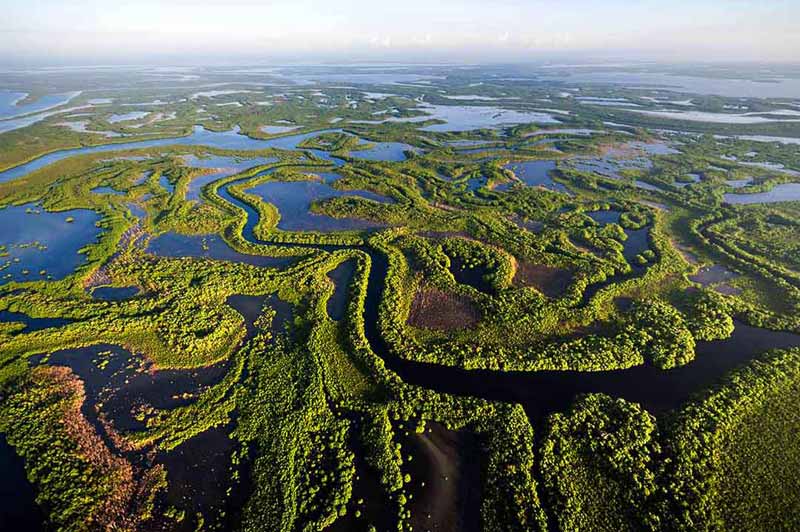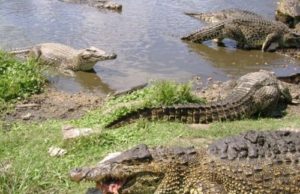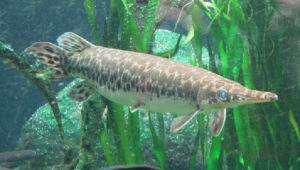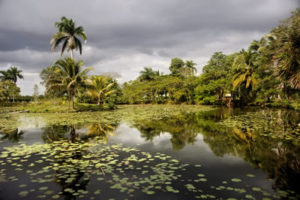The wetlands of Cuba represent about 4% of the island’s territory and include habitats with unique and ideal vegetation for numerous organisms such as manatis, crocodiles, fish and turtles, many resident and particularly migrant birds and numerous endangered endemic species. The Zapata Swamp, the largest wetland in Cuba, is also the largest in the Caribbean, and the best preserved to date in the Antilles, although it is currently subject to numerous threats
According to experts some serious threats for the region are drainage, agricultural expansion and the pollution associated with it, production of charcoal, grazing, extraction of peat and the invasion of exotic species. The development of aquiculture (780 ha) creates reproductive and nutritive stresses to the detriment of local freshwater ichthyofauna. Manjuarís as well as other fish species are highly sensitive to pesticide contamination and are very affected by the introduction of exotic species.
The principal enemy is human poachers. Fish populations are declining considerably in locations where they used to be abundant. The felling of trees, whether on a mass-scale or not, has been used historically to obtain charcoal and constitutes one of the more significant direct threats to forest ecosystems and to biological diversity in general. Combined with this practice, selective cutting of the underbrush to obtain poles and timber-yielding species also seriously comprises the regeneration of the forest.
Added to this is the forest fires that have a great effect on freshwater grasslands and compromise other forested areas of the territory. Continuous hunting of jutías by peasants to make up for government neglect of the supply, and the cutting of endemic palms that are used by psitacidae, strigiformes, piciformes, trogonidae and other species of avifauna to build their nests have been increasing in recent years due to the increase in personnel from the Youth Labor Army who, in the absence of sanctions and with the complicity of forest rangers themselves, knock palms down every day in their search for young parrots and as a lucrative way to pass the time while in military service. There are entire palm groves cited in current scientific literature that no longer exist, and there is no doubt that within a few years, if this irrational destruction is not stopped, the Zapata Swamp will cease to be the important natural enclave that it was in the past (Wotzkow 1998).
There are about 900 plants with 13% (150 species) of endemisms on the island and some 212 species of vertebrates (17.9% endemic), not including a great variety of insects and other invertebrates. There are five local endemic plant species and a similar number of fauna species, and 16 species are in danger of becoming extinct. According to Davis et al. 1997, the wetlands of the province of Pinar del Río and those in Zapata are included within one of the three most important centers of plant diversity and endemism in Cuba. At the Northern are of Santo Tomas and other areas of the island the forests and other species have disappeared in Cuba such Cuban pygmy owl, sijú cotunto, garzas reales, las cotorras and Amazona leucocephala, zunzuncito, Blue-headed pigeon, Northern Flicker and Fernandina’s Flicker or passeriforms like the chillina, cabrero, chichinguaco, mayito de ciénaga and the tomeguines de la tierra and pinar, which are also currently extremely vulnerable as a result of constant transformations occurring in their habitats (Wotzkow 1998).
Some years ago an international hunting reserve was created within the Birama swamp in which the list of hunted species was increasing. Despite this abuse, the largest problem is not that associated with this sui generis method of increasing the list of species that can be captured, but rather the problem of salinity in the aquatic ecosystem. Taking advantage of the condition of lowlands to the east, north and south of the swamp, large areas have been used to grow rice. As a result, a considerable amount of pesticides such as DDT, DDE, and other organochlorated products (prohibited in many countries due to the harmful effects on human health and ecosystems) are regularly sprayed by airplane and gravity carries them toward the surrounding lagoon and marshes through the vast network of existing canals.
In conjunction with this, intense deforestation in the Sierra Maestra (as of 1992 it was 63 %) has caused the Cauto river, Cuba’s largest river, to become nothing more than a stream in the dry season. This impoverishment of the volume of water in the river decreases the contribution of water to the swamp where salinization has begun to take on a very rapid pace. Thus, there has been a considerable decline in the nutrients on which many microorganisms, crustaceans, fish and birds depend, and in some places the landscape has become truly desolate. Added to all the preceding is the fact that a large number of fishing cooperatives operate in the Birama swamp.
The unlimited capture of crocodiles, jicoteas, and endemic fish like the biajaca is being carried out there in a completely irrational way. These operations are for local consumption and commercial export, but they are carried out in clear violation of provisions of the CITES treaty to which Cuba is a signatory (Wotzkow 1998).
The potential effect of a higher sea level due to global warming does not fail to affect the Zapata region, one of the country’s most endangered areas. According to some estimates, by the year 2030 the potential floodable area of the coastline will reach 70% and would involve 1-2 Km of the coast and possibly be more severe toward the Occidental Swamp (up to 4 Km) (Habitats terrestres Cuba 1997).
SERIAS AMENAZAS A LA FLORA Y FAUNA DE CUBA. ESPECIES EN PELIGRO DE EXTINCIÓN.
Los humedales de Cuba representan aproximadamente el 4% del territorio de la isla e incluyen hábitats con vegetación única e ideal para numerosos organismos como manatis, cocodrilos, peces y tortugas, muchas aves residentes y particularmente migratorias y numerosas especies endémicas en peligro de extinción. El pantano de Zapata, el humedal más grande de Cuba, también es el más grande del Caribe y el mejor conservado hasta la fecha en las Antillas, aunque actualmente está sujeto a numerosas amenazas.
Según los expertos, algunas amenazas graves para la región son el drenaje, la expansión agrícola y la contaminación asociada a ella, la producción de carbón, el pastoreo, la extracción de turba y la invasión de especies exóticas. El desarrollo de la acuicultura (780 ha) crea estrés reproductivo y nutritivo en detrimento de la ictiofauna local de agua dulce. Los manjuarís y otras especies de peces son muy sensibles a la contaminación por plaguicidas y se ven muy afectados por la introducción de especies exóticas.
El enemigo principal son los cazadores furtivos humanos. Las poblaciones de peces están disminuyendo considerablemente en lugares donde solían ser abundantes. La tala de árboles, ya sea a gran escala o no, se ha utilizado históricamente para obtener carbón vegetal y constituye una de las amenazas directas más importantes para los ecosistemas forestales y la diversidad biológica en general. Combinado con esta práctica, el corte selectivo del sotobosque para obtener polos y especies que producen madera también comprende seriamente la regeneración del bosque.
A esto se suman los incendios forestales que tienen un gran efecto en las praderas de agua dulce y comprometen otras áreas boscosas del territorio. La caza continua de jutías por parte de los campesinos para compensar el descuido del suministro por parte del gobierno, y el corte de palmas endémicas que son usadas por psitacidae, strigiformes, piciformes, trogonidae y otras especies de avifauna para construir sus nidos han aumentado en los últimos años debido a el aumento de personal del Ejército Juvenil de Trabajadores que, en ausencia de sanciones y con la complicidad de los guardabosques, bajan la palma de la mano todos los días en su búsqueda de loros jóvenes y como una forma lucrativa de pasar el tiempo mientras están en el servicio militar. Hay palmares enteros citados en la literatura científica actual que ya no existen, y no hay duda de que dentro de unos años, si esta destrucción irracional no se detiene, el Pantano de Zapata dejará de ser el enclave natural importante que fue en el pasado (Wotzkow 1998).
Hay alrededor de 900 plantas con un 13% (150 especies) de endemismos en la isla y unas 212 especies de vertebrados (17.9% endémicas), sin incluir una gran variedad de insectos y otros invertebrados. Existen cinco especies locales de plantas endémicas y un número similar de especies de fauna, y 16 especies están en peligro de extinción. De acuerdo con Davis et al. 1997, los humedales de la provincia de Pinar del Río y los de Zapata se incluyen dentro de uno de los tres centros más importantes de diversidad de plantas y endemismo en Cuba. En el norte de Santo Tomás y otras áreas de la isla, los bosques y otras especies han desaparecido en Cuba como el búho pigmeo cubano, sijú cotunto, garzas reales, las cotorras y Amazona leucocephala, zunzuncito, paloma cabezona, Parpadeo norteño y Fernandina Parpadeo o paseriformes como la chillina, cabrero, chichinguaco, mayito de ciénaga y las toméguines de la tierra y el pinar, que también son actualmente extremadamente vulnerables como resultado de las constantes transformaciones que ocurren en sus hábitats (Wotzkow 1998).
Hace algunos años, se creó una reserva de caza internacional dentro del pantano de Birama, en la que la lista de especies cazadas estaba aumentando. A pesar de este abuso, el mayor problema no está relacionado con este método sui generis para aumentar la lista de especies que pueden capturarse, sino más bien el problema de la salinidad en el ecosistema acuático. Aprovechando la condición de las tierras bajas al este, norte y sur del pantano, grandes áreas se han utilizado para cultivar arroz. Como resultado, una gran cantidad de pesticidas como DDT, DDE y otros productos organoclorados (prohibidos en muchos países debido a los efectos nocivos en la salud humana y los ecosistemas) son regularmente rociados por avión y la gravedad los lleva hacia la laguna y marismas circundantes. a través de la vasta red de canales existentes.
Conjuntamente con esto, la intensa deforestación en la Sierra Maestra (a partir de 1992 era del 63%) ha hecho que el río Cauto, el río más grande de Cuba, se convierta en nada más que un arroyo en la estación seca. Este empobrecimiento del volumen de agua en el río disminuye la contribución del agua al pantano donde la salinización ha comenzado a tomar un ritmo muy rápido. Por lo tanto, ha habido una disminución considerable en los nutrientes de los que dependen muchos microorganismos, crustáceos, peces y aves, y en algunos lugares el paisaje se ha vuelto verdaderamente desolado. A todo lo anterior se suma el hecho de que un gran número de cooperativas pesqueras operan en el pantano de Birama.
La captura ilimitada de cocodrilos, jicoteas y peces endémicos como la biajaca se lleva a cabo allí de una manera completamente irracional. Estas operaciones son para el consumo local y la exportación comercial, pero se llevan a cabo en clara violación de las disposiciones del tratado CITES del que Cuba es signatario (Wotzkow 1998).
El efecto potencial de un mayor nivel del mar debido al calentamiento global no deja de afectar a la región de Zapata, una de las áreas más amenazadas del país. Según algunas estimaciones, para el año 2030 el área inundable potencial de la costa alcanzará el 70% y abarcará 1 a 2 km de la costa y posiblemente será más grave hacia el pantano occidental (hasta 4 km) (Hábitats terrestres Cuba 1997). )
Agencies/Wiki/WWF/PBS/Internet Photos/Excerpts/YouTube/ Arnoldo Varona/ TheCubanHistory.com
THE CUBAN HISTORY, HOLLYWOOD.










